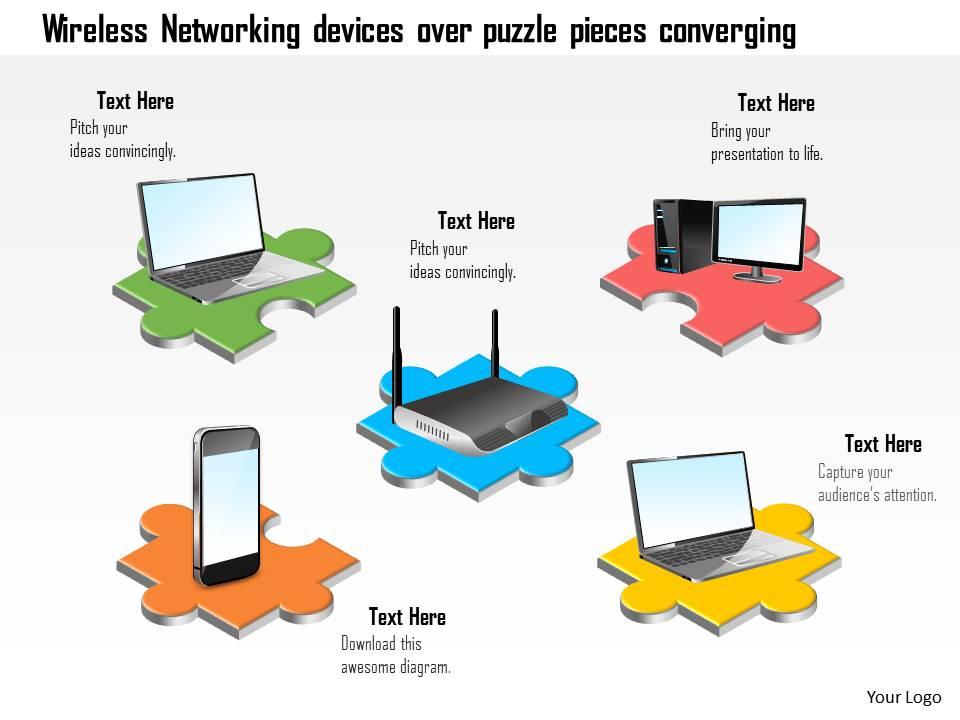
Wireless Networked Digital Devices
In the continuously changing landscape of technology, wireless networked digital gadgets have emerged as the driving force behind a revolution that is bringing about a transformation. An era of unparalleled connectedness and convenience is being fostered by these devices, which include smartphones, smartwatches, and devices connected to the Internet of Things (IoT). These devices are connecting individuals and enterprises in a seamless manner.
Emergence of Wireless Connectivity as a Reality
When it comes to digital devices that are connected to wireless networks, the story begins with the unrelenting search of connectivity. In times not too distant in the past, wired connections were the standard, which restricted mobility and limited the possibilities of digital gadgets. The introduction of wireless technology brought about a paradigm shift, which freed gadgets from the constraints of being physically connected to one another.
Wi-Fi, Bluetooth, and cellular networks are just few of the technologies that have made wireless networking possible, which has led to its widespread adoption. Through its use, individuals have been given the ability to access information, connect with one another, and operate devices without being confined to a certain area. The expansion of digital gadgets has been fueled by the convenience that wireless connections provide, which has resulted in these devices being an essential component of our day-to-day lives.
An Increase in the Number of Intelligent Devices
The broad use of wirelessly networked digital devices is best exemplified by the proliferation of smartphones. These pocket-sized powerhouses have progressed beyond the role of simple communication tools, becoming necessary companions that can be effortlessly integrated into a variety of facets of our life. Smartphones have evolved into multipurpose hubs that respond to our different demands, accommodating anything from the management of schedules and the navigation of city streets to the capture and sharing of meaningful moments.
An ecosystem of smart gadgets has arisen in addition to the proliferation of smartphones. Wearable technologies such as smartwatches, fitness trackers, and other similar devices are bringing about a revolution in the monitoring of personal health and offering access to information in real time. Living spaces are becoming more intelligent and interconnected as a result of the proliferation of smart home gadgets, which include everything from thermostats and lighting systems to security cameras.
Bringing the Unseen Together Through the Internet of Things
The Internet of Things (IoT) has arisen as a revolutionary force, connecting not just people but also inanimate objects. This is due to the advancements that have been introduced in wireless technology. Sensors and communication capabilities are now being incorporated into everyday goods, which enables these items to communicate with one another and collect data simultaneously. This network of networked gadgets, often known as the Internet of Things (IoT), holds tremendous promise across a variety of industries.
In the field of medicine, Internet of Things devices are bringing about a revolution in patient care through services such as remote monitoring, smart implants, and data-driven insights. Smart sensors are helping to improve crop management in agriculture by delivering information in real time about the state of the soil, the characteristics of the weather, and the development of the crop. The industrial sector is reaping the benefits of Internet of Things-enabled predictive maintenance, which is lowering downtime and optimizing operational efficiency efficiencies.
Opportunities and Obstacles to Overcome
Despite the fact that the growth of wireless networked digital devices has ushered in a new era of connectedness, it also presents issues that need to be addressed. The most pressing worries are those pertaining to security, which include everything from data leaks to illegal access. The number of devices that are connected to one another increases, which in turn increases the potential attack surface for cyber attacks. It is absolutely necessary to implement stringent cybersecurity measures in order to protect the confidentiality and authenticity of the massive amounts of data that are sent between these devices.
The interoperability of different devices and standards is another problem that must be overcome. As more and more manufacturers offer a wide variety of smart devices, it is becoming increasingly important to ensure that there is smooth communication across the various brands and models. The process of standardization is currently under way in order to define standards that will ease interoperability and create an environment that is cohesive.
In spite of these obstacles, the prospects that are given by digital devices that are integrated into wireless networks are enormous. The scope of the potential for positive influence is extremely broad, ranging from the enhancement of everyday conveniences to the improvement of healthcare results and the optimization of industrial operations. The incorporation of artificial intelligence (AI) into wireless devices holds the potential to enhance their capabilities, hence enabling more intelligent decision-making and more personalized experiences. This is anticipated to occur as technology continues to advance.
We are going to delve deeper into particular industries that are influenced by wireless networked digital devices, and we are going to investigate the complexities of their influence on healthcare, smart cities, and industrial applications. Furthermore, we will investigate the ever-changing landscape of wireless communication technologies, ranging from the possibilities of future technologies such as Li-Fi to the 5G networks that are being deployed. In this voyage, we will unravel the complex tapestry of wireless connectivity, investigating how technology is transforming our world and propelling us into an era of limitless possibilities. We invite you to join us on this adventure.
Within the Healthcare Industry, Wireless Networked Digital Devices
The healthcare sector is on the verge of experiencing a technological revolution, which will be largely driven by the incorporation of digital equipment that are wirelessly networked. Wearable fitness trackers and remote patient monitoring systems are just two examples of the ways in which these gadgets are being used to revolutionize the delivery and experience of healthcare.
Patient Monitoring Via Remote Access
When it comes to healthcare, one of the most important contributions that wireless devices have made is in the field of remote patient monitoring. It is now possible to equip patients who suffer from chronic diseases with wearable gadgets that continuously monitor vital signs and provide medical professionals with data in real time. Because of this, not only is preemptive intervention possible, but it also lessens the need for repeated visits to the hospital, which in turn improves patient comfort and lowers the overall cost of healthcare.
As well as Virtual Health and Telemedicine
The combination of wireless technology and medical care has resulted in the development of telemedicine and technologies that provide virtual health services. Patients now have the ability to receive medical advice and services without having to leave the comfort of their own homes thanks to the advent of video consultations, remote diagnostics, and virtual health platforms. This has proven to be quite useful in circumstances where it is difficult to physically be there, as was seen during global occurrences such as the COVID-19 epidemic.
Medications that can be worn
The use of wearable technology has evolved into an essential tool for people who are concerned about their health. The capabilities of smartwatches and fitness trackers include the monitoring of activities, heart rate, and sleep habits, which provides users with insights into their general health and wellness. It is possible to share this information with healthcare practitioners, which will help to build a collaborative approach to maintaining preventive care.
There is a tremendous deal of potential in the combination of wireless connectivity and healthcare; yet, there are also worries over the privacy and security of stored data. As the data pertaining to health becomes increasingly digital and networked, it is imperative that rigorous safeguards be put into place to safeguard sensitive information and guarantee compliance with privacy requirements.
The Transformation of Urban Living Through Smart Cities
The idea of smart cities encompasses the concept of urban areas that make use of technology in order to improve the overall quality of life for residents, as well as the efficiency and sustainability of the urban environment. The realization of this vision is largely dependent on the utilization of digital gadgets that are connected to wireless networks.
Infrastructure that is Intelligent
The monitoring and management of vital infrastructure is the responsibility of smart cities, which employ a network of sensors and devices. Real-time data collection and analysis is performed by these devices, which are used in a wide variety of applications, including electricity grids, water supply networks, and traffic lights of various kinds. Through the utilization of this information, authorities are able to maximize the utilization of resources, lessen their influence on the environment, and improve the general functionality of urban infrastructure.
Protection of the Public and Safety
Within the context of smart cities, wireless gadgets make a substantial contribution to the public safety and security. The ability of law enforcement and emergency services to monitor situations and respond to them in a timely manner is improved by the use of surveillance cameras, networked emergency response systems, and smart lighting. As a consequence, the urban environment ended up being safer and more secure.
The Monitoring of the Environment
Intelligent cities make use of wireless devices in order to monitor and manage environmental concerns in response to the growing emphasis on sustainability on a global scale. The implementation of waste management systems, noise monitoring devices, and air quality monitors all help to the creation of a more beneficial and sustainable urban habitat. With this strategy, which is driven by data, it is possible to make decisions based on evidence in order to address environmental concerns.
There is little question that smart city programs have the potential to bring about positive outcomes; yet, they also present issues in terms of data privacy, cybersecurity, and the ethical application of technology. The establishment of solid governance structures and careful analysis are required in order to achieve a balance between the protection of individuals’ rights and the promotion of innovation.
Applications for Industry: Industry 4.0 and Beyond the Industry
Industry 4.0 is a new era that has emerged in the industrial sector as a result of the integration of wireless networked digital devices. This new era is defined by the convergence of digital technologies, automation, and data sharing.
Maintenance that is Predictive
Across sectors, wireless sensors and Internet of Things devices are bringing about a revolution in maintenance methods. The implementation of predictive maintenance techniques is something that organizations may do by regularly monitoring the operation of their equipment and gathering data on the health of their machines. This proactive strategy reduces the amount of time that equipment is not in use, increases the lifespan of the equipment, and maximizes organizational effectiveness.
The optimization of the supply chain
Tracking and monitoring of products in transit can be accomplished in real time thanks to the interconnected nature of wireless devices. RFID tags and sensors that are coupled with GPS technology are examples of the types of devices that give supply chain managers visibility into the movement of products. This visibility enables improved inventory management, which in turn reduces losses and improves the overall efficiency of the supply chain.
Enhanced Robotics and Automation Technologies
One of the most important factors that enables automation in manufacturing processes is wireless connectivity. The use of wireless communication in smart factories allows for the coordination and management of robotic systems, which in turn improves the manufacturing process in terms of precision, efficiency, and flexibility. This results in a rise in both the quality of the product and the company’s competitiveness in the international market.
Interoperability, data standardization, and cybersecurity are some of the difficulties that sectors need to face as they embrace digital transformation. In order to achieve a smooth integration of wireless technology into industrial processes, extensive planning and investment in the appropriate infrastructure are required.
The Development of Technological Advancements in Wireless Communication
There is a close connection between the development of wireless communication technology and the success of digital gadgets that are networked wirelessly across the internet. Every generation has brought forth tremendous breakthroughs, beginning with the early days of 2G and continuing all the way up to the current era of 5G.
Putting the Future Within Reach: 5G Networks
The introduction of 5G networks is a significant step forward in the technological development of wireless communication. New possibilities for wireless devices are made available by 5G, which features data transfer rates that are exponentially higher, decreased latency, and larger device capacity. It serves as the foundation for the expansion of the Internet of Things (IoT), making it possible to link a wide variety of devices in real time without any interruptions.
Beyond the 5G Network: Exploring the Future Frontiers
Technological advancements beyond 5G are already being investigated by researchers as we move farther into the future. These developments, which are referred to as 6G and beyond, are working toward the goal of pushing the limits of wireless communication even further. Terahertz communication, holographic-type connectivity, and quantum communication are examples of concepts that have the ability to reimagine the capabilities of digital devices that are connected to wireless networks.
We are going to delve into the complexities of wireless communication technologies in the following section of our investigation. We are going to investigate the relevance of fifth-generation wireless (5G) technology, the promise of developing technologies, and the influence that these improvements have had on the landscape of connectivity.
The trip into the realm of wireless technology continues, and as it does so, it is unwinding the threads of innovation and connectivity that are knitting the fabric of our future interconnectedness. As we make our way through this environment, it is becoming increasingly clear that the true potential of digital gadgets that are connected to wireless networks has not yet been fully realized. As we continue to delve into the unfolding chapters of this technological drama, where each page exposes new possibilities and problems in the area of wireless communication, we invite you to join us in the next installment.
An Overview of the Technological Landscape of Wireless Communication
A Look at the Importance of 5G
In the realm of wireless communication technologies, the introduction of 5G represents a monumental leap, as it promises to deliver speeds, reliability, and connectivity that have never been seen before. A wide range of applications, including augmented reality (AR) and virtual reality (VR), as well as driverless vehicles and smart cities, are made possible by this fifth-generation technology, which is not only an incremental increase but rather a disruptive force that enables these applications.
Improvements in Both Speed and Capacity
The ability of 5G to produce data speeds that are substantially higher than those of its predecessors is one of the most important characteristics of this technology. With download rates reaching up to 10 gigabits per second, customers are able to stream high-definition content, download huge files, and engage in activities that need a significant amount of bandwidth while experiencing little latency. An further benefit of 5G networks is that they have a larger device capacity, which enables a significantly greater number of simultaneous connections.
Communication with a reduced latency and in real time
The reduction of latency is of utmost importance for applications that require real-time communication, such as video conferencing, online gaming, and autonomous vehicles. With reaction times as short as one millisecond, 5G is able to offer extremely low latency connectivity. The implementation of applications that were previously hampered by delays in data transmission is made possible by this low latency, which is a game-changer.
The Revolution of the Internet of Things (IoT)
The Internet of Things should be able to reach its full potential, and 5G is a key factor in making that possible. 5G networks are perfect for connecting the enormous array of Internet of Things devices because of their improved device capacity, low latency, and enhanced dependability. 5G is the technological foundation upon which the interconnected future is built. It is used in everything from healthcare gadgets and autonomous machines to smart homes and industrial sensors.
Emerging technologies are influencing the years to come.
Beyond 5G: 6G and Other Technologies
Researchers and engineers are already investigating the potential of the next frontier, which is 6G and beyond, even as the rollout of 5G continues to take place from country to country. The capabilities of 5G are going to be surpassed by these upcoming wireless communication technologies, which are also going to address existing difficulties.
The Communication of Terahertz
Terahertz (THz) communication, which runs at frequencies higher than those of 5G, is one of the promising avenues that can facilitate communication. Terahertz waves have the ability to carry data at extraordinarily high speeds, which paves the way for applications such as streaming video in exceptionally high definition and instantaneous data transfer.
The Connectivity of the Holographic Type
An other concept that is currently being investigated is holographic-type connectivity, which is a scenario in which wireless signals might be molded and steered in three-dimensional space. It is possible that this technology will make it possible for devices to communicate with one another in a more effective and precise manner, thereby overcoming hurdles and improving signal strength in difficult circumstances.
Communication in Quantum Space
The concept of quantum communication is at the forefront of the field of inquiry. The purpose of this technology is to develop communication networks that are extremely secure and resistant to the conventional methods of hacking. It does this by utilizing the principles of quantum physics. Despite the fact that it is still in its infancy, quantum communication has the potential to completely transform the way data security is handled in the wireless realm.
Repercussions for both society and connectivity
There are far-reaching ramifications for connection and for society as a whole that are brought about by the development of wireless communication technology. There are many parts of our day-to-day lives that are impacted by the seamless integration of high-speed, low-latency networks.
Altering the Industries Around Us
The developments in wireless communication have the potential to substantially benefit industries, particularly those that are adopting the fourth industrial revolution (Industry 4.0). The capability to transfer and handle enormous amounts of data in real time is a game-changer for not only the manufacturing and logistics industries, but also for other industries. The improved productivity and automation that are made possible by these technologies contribute to the expansion of the economy and the enhancement of competitiveness.
Making Innovation Possible
Innovative ideas are encouraged across a wide range of industries thanks to the faster and more dependable connectivity that is made possible by modern wireless technologies. The capacity to access and share data in real time opens up new opportunities in a variety of fields, including agriculture, education, and healthcare, among others. The development of wireless communication has made it possible for innovations such as remote surgery, immersive educational experiences, and precision agriculture to become more feasible.
Making Smart Cities a Reality
The development of smart cities, which are brought about by powerful wireless networks, is ongoing. The introduction of 5G and other future technologies will expand the capabilities of smart city efforts, which will result in urban environments that are more efficient, sustainable, and habitable. The impact of wireless connectivity on urban living is significant, ranging from the implementation of data-driven governance to the development of intelligent transportation systems.
Considerations and Obstacles to Overcome
Nevertheless, this trip into the future of wireless telecommunications is not devoid of difficulties. Concerns regarding infrastructure, security, and ethical considerations are raised as a result of the widespread deployment of 5G and the investigation of technologies that go beyond 5G.
The Construction of Infrastructure
A large amount of infrastructure construction is required in order to prepare for the shift to advanced wireless technologies. In order to support the greater frequencies and capacities, the deployment of 5G networks requires the updating of the infrastructure that is already in place as well as the installation of new equipment. For this process to be successful, considerable investments and coordinated efforts from stakeholders across sectors and governments are required simultaneously.
Safety as well as Confidentiality
Concerns around privacy and security are growing in tandem with the expansion of connectivity. Because of the large amounts of data that are exchanged between devices and networks, there are potential for cyber attacks and breaches of privacy from occurring. The implementation of stringent cybersecurity safeguards, encryption systems, and compliance with privacy legislation are all necessary in order to address these difficulties.
Matters with Ethical Implications
The integration of digital devices that are networked wirelessly poses ethical problems of surveillance, ownership of data, and the possibility for technology to be misused. A thorough analysis and the formation of ethical frameworks to guide the appropriate development and deployment of wireless technologies are required in order to achieve a balance between the protection of individual rights and the promotion of innovation.
Final Thoughts
The progression of wirelessly networked digital devices and communication technologies is a journey that is both constantly evolving and undergoing significant change. Beginning with the revolutionary impact of fifth-generation wireless (5G) and continuing with the research of future frontiers such as terahertz communication and quantum connectivity, each step gets us closer to a world of possibilities that are virtually limitless. In the process of navigating this technological environment, it is of the utmost importance to solve difficulties, place a priority on security and privacy, and make certain that the advantages of wireless connectivity contribute to a future that is more connected, smarter, and inclusive for everyone. The narrative of wireless connectivity is still in the process of being written, and the chapters that have not yet been written promise to be a fascinating and ever-evolving tale in the fabric of our interconnected world.

Geeta Technical Hub
Related Posts

Career Path for B. Sc In Nutrition and Dietetics – Geeta University
Career Path for B. Sc In Nutrition and Dietetics – Geeta University Many students today choose academic disciplines that are all related to health management.

How Color Influences Guest Experience in Hotels
THE PALETTE OF EMOTIONS: HOW COLOR INFLUENCES GUEST EXPERIENCE IN HOTELS Any hotel lobby will have carefully chosen colors for the walls, furnishings, and other
Cultural Competence in Communication
In today’s interconnected world, cultural competence in communication stands as a cornerstone for meaningful interaction and collaboration. Cultural competence refers to the ability to effectively


